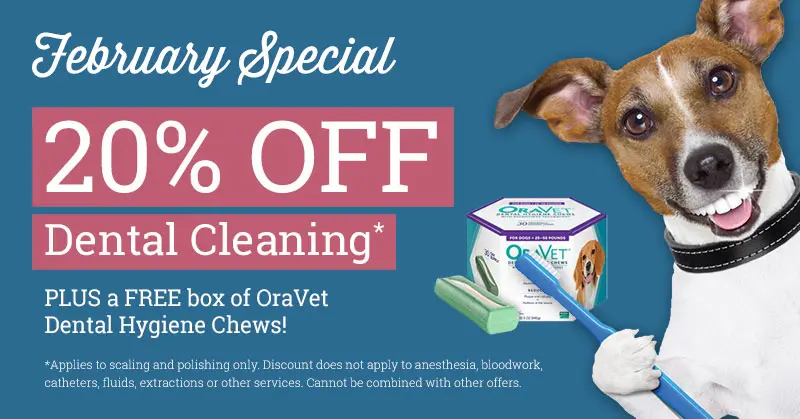February is National Pet Dental Health Month: What You Should Know

Studies have shown that a healthy mouth can actually add years to your pet’s life. 80% of dogs and 70% of cats will have some form of dental disease before they turn three. Dental problems don’t just affect the mouth, either. Dental disease can have adverse effects on the heart, kidneys, and other major organs. By performing routine cleanings before there are significant problems, we help our pets stay healthier longer. Don’t turn your nose to Fido’s or Fluffy’s bad breath! That odor might signify a serious health risk, with the potential to damage not only your pet’s teeth and gums but its internal organs as well.
Periodontal Disease
Periodontal disease is the most common problem affecting pets in all age groups. Diseases that affect the oral tissues can cause the teeth to fall out. There are primary organ diseases that can cause oral lesions. Finally, periodontal disease can have a secondary effect on major organs, causing or exacerbating organ system diseases. The very best way to prevent periodontal disease is daily dental home care, but it is useful to add in effective, evidence-based dental food to provide daily plaque control. The specific risk factors that can contribute to periodontal disease in dogs include:
- Breed: Purebreds, small dogs, and pets with short muzzles are prone to overcrowding and rotation of teeth, as well as misalignment.
- Age: The older the pet, the longer dental disease has to accumulate.
- Immune system health: A healthy immune system contributes to a healthy mouth.
Nutrition can contribute to preventing periodontal disease and gingivitis. The food’s texture and make-up can affect the environment of the mouth. It can help maintain tissue integrity, stimulate saliva production, alter plaque bacteria metabolism, and provide mechanical cleansing of tooth surfaces. It was commonly recommended to feed dry food to prevent periodontal disease in pets. However, in clinical studies, dry food alone did not contribute to improved oral health. This points out the importance of choosing a nutrient profile that has been developed to enhance oral health. Your veterinarian can make a specific nutritional recommendation of a product proven to be effective in enhancing canine/feline oral health. Dental food kibbles are built differently from conventional kibbles. They are bigger, forcing the animal to actually chew them. The kibbles act like a squeegee, swiping the plaque from the tooth as the pet bites through them.
At Home Dental Care
Brush your pet’s teeth! Even if you can’t brush every day, developing a routine with your pet is one of the most effective ways of stopping plaque and tartar buildup.
Introduce your pet to tooth brushing slowly using lots of praise. Start by introducing your finger into the mouth (dipping it in something tasty like broth or tuna helps!)
Keep sessions short and positive!
Once your pet tolerates your finger, you can slowly introduce a soft, wet toothbrush.
Once your pet tolerates brushing you can introduce him to a special veterinary toothpaste. Never use human toothpaste for your pet. Human dentifrice or toothpaste should never be used in dogs. Human teeth cleaning detergents contain ingredients that are not intended to be swallowed and can cause internal problems if they are swallowed. Human products also commonly contain higher levels of salt which can be a problem for some dogs. You should also avoid using baking soda to clean your dog’s teeth. Baking soda has a high alkaline content and, if swallowed, it can upset the acid balance in the stomach and digestive tract. In addition, baking soda does not taste good, which may cause your dog to be uncooperative when you try to brush her teeth. Numerous pet toothpaste are non-foaming, safe to be swallowed and available in flavors that are appealing to pets including poultry, beef, malt and mint. If you use a product that tastes good, your dog/cat will be more likely to enjoy the whole experience. In addition to the pleasant taste, many of these toothpaste contain enzymes that are designed to help break down plaque chemically, which reduces the time you need to actually spend brushing your dog’s teeth.
Don’t force it. Some pets do not allow their teeth to be brushed. If your pet becomes irritated or aggressive, don’t push the issue.
Utilize products advocated by your veterinarian to help prevent plaque and tartar. Certain treats and foods have been shown to help prevent the buildup of plaque and tartar. These are particularly helpful for pets that do not tolerate brushing. We would be happy to assist you in selecting products appropriate for your pet.
Avoid table scraps! These increase the speed at which plaque and tartar accumulate, as well as causing other problems.
See your vet. Your pet’s semi-annual wellness appointments are the best time to discuss your pet’s dental health and what further steps should be taken.
Professional Dental Care
To keep your pet’s teeth and gums healthy, we recommend a thorough dental cleaning. By taking some simple steps at home, however, you may be able to help prevent problems that result in more extensive dental work.
When rough tartar accumulates on tooth surfaces and touches the gum line it’s time for a professional oral assessment, treatment, and prevention visit. This visit will include a thorough dental examination, teeth cleaning, and polishing to remove the tartar and invisible plaque from all of the tooth surfaces. Your veterinarian may perform pre-anesthetic blood tests to ensure that kidney and liver function are satisfactory for anesthesia, as well as an evaluation of the heart and abdomen if needed. For proper dental care, your pet will be placed under general anesthesia.
Once your pet is under general anesthesia, your veterinarian and veterinary assistants will thoroughly examine the mouth, noting abnormalities in the medical record. A dental probe will be used to evaluate gum bleeding and periodontal pockets where food can accumulate if not cared for. After examination, tooth scaling will be performed, using both hand and ultrasonic scalers to remove tartar above and below the gum line. The tartar below the gum line causes the most significant periodontal disease, so it is important that it be thoroughly removed.
After scaling, the teeth are polished to remove microscopic scratches and decrease the rate of plaque build-up. Special applications such as fluoride, antibiotic preparations and cleaning compounds may be used to decrease tooth sensitivity, strengthen enamel, treat bacterial infection and reduce future plaque accumulation. The procedures your pet may require will be discussed with you before her dental cleaning. Since it can be difficult to predict the extent of dental disease in advance of the procedure, it is imperative that your veterinarian be able to reach you during the procedure to discuss any additional treatment that may be necessary. When periodontal disease is advanced, it may not be possible to save the badly affected teeth, which may need to be extracted.
Good dental hygiene can add years to your pet’s life. Even though pets don’t often get cavities, they are susceptible to periodontal or gum disease, which is the number one illness found in both dogs and cats. That’s why it’s so important that pet lovers include dental hygiene in their animals’ health and wellness routine. To help keep your pets smiling bright, we celebrate Pet Dental Health Month this February – making this the perfect time to get your furry friend on a proper dental regimen.

Share This Post
Recent Posts
About Shallowford Animal Hospital
Shallowford Animal Hospital and The Pet Spa at Shallowford are dedicated to the exceptional, compassionate care your pet deserves. Pets hold a very special place in our families, and we treat yours like our own.



